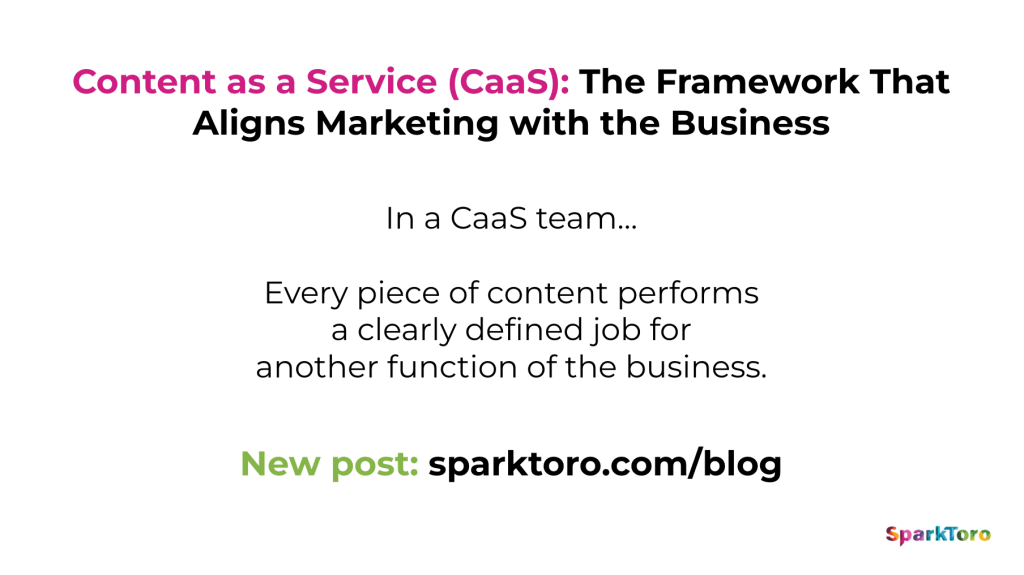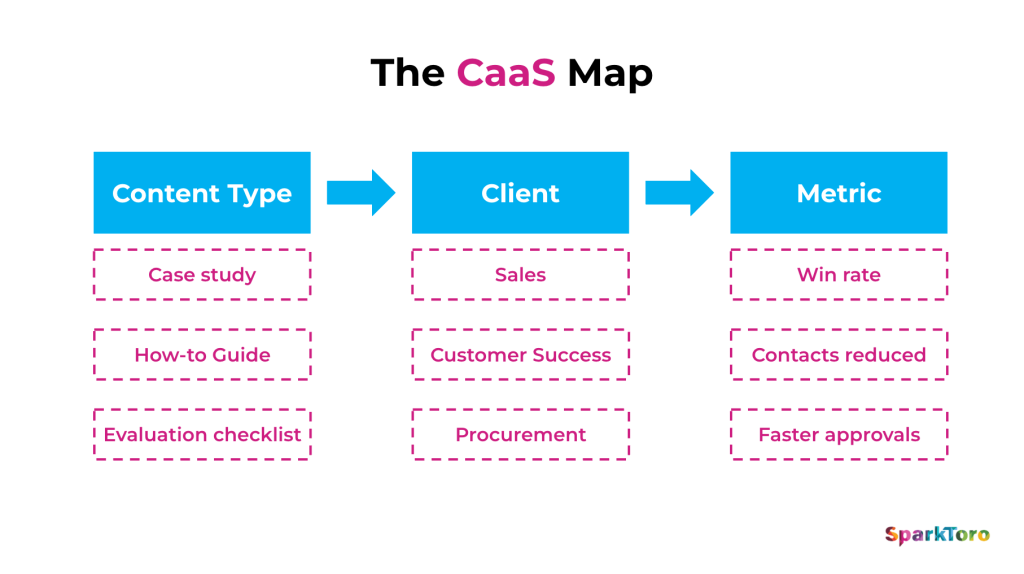Marketing often treats content like a vending machine. Sales needs a case study, so you fill in the template. Check the next row on the spreadsheet, write a blog post about that keyword. Insert a Jira ticket, get a graphic version of that blog post.
That’s how you end up “keeping the lights on” with content… that does nothing.
Because when content’s treated like a request line, you end up optimizing for output, not outcomes. Everyone’s busy, but nothing moves the business forward. Sales keeps saying, “We need better content,” Marketing says, “We need better distribution,” and leadership wonders what content even does.
The problem is misalignment.
The fix is simple and operational: treat Content as a Service (CaaS). Every piece of content exists to perform a clearly defined job for another function of the business. If your content can’t tell you what job it does and who it serves, it’s not ready to ship.
(Keep reading to the end because there’s a template in this blog post, and there’s a podcast version of this advice!)

What “Content as a Service” Actually Means
Content is a service provider to Sales, Success, Product, Partnerships, and Demand Generation. It has clients (internal teams), jobs (business outcomes), service agreements (how/when it’ll be used), and metrics (how we’ll know it worked). This was how I ran my previous content teams, across both B2B and B2C industries. When I ran content at Fitbit B2B, this shift was the unlock that made our content team indispensable. Once Sales started coming to us first instead of last, our output went down — but our impact went way up. We stopped publishing just to fill an editorial calendar and started producing fewer assets that closed deals.
I actually talked about this idea — and how “content as a service” changes how teams work — on my friend Corey Wilks’ podcast, Creator Alchemy. Corey’s a psychologist, so we got into the psychology behind why marketers burn out when content is treated like a vending machine and how reframing it as a service builds trust and alignment across teams.
Once content started solving other teams’ problems, not just producing outputs, we earned a seat at the table. That’s the whole point of treating content as a service — it’s not about more content, it’s about more useful content.
This shift moves away from “writing two blog posts per week,” although, sure, some level of defined output is helpful. With CaaS, you think more like: “deliver two assets this month that reduce sales cycle length by 10%” or “ship one asset that deflects 20% of repetitive support tickets.” The key performance indicators aren’t just pageviews and owned keywords — the KPIs reflect business improvements. (Now is probably a good time to share our thoughts on KPIs for content quality. Here’s Rand’s take on content/business KPIs, and here’s my take as well.)
With CaaS, every type of content has a job to do and a client it serves. Here’s how it maps out…
The CaaS Map: Content Type → Client → Metric

Here are some common pairings I’ve seen work across orgs. You can use them to sanity-check requests:
Case Study → Sales Enablement
- Client: Sales
- Success metrics: Win rate, sales cycle time, influenced pipeline
- Notes: Must match target ICP, objection handled, decision criteria.
How-to Guide / Product Tutorial → Customer Success
- Client: CS/Support
- Success metrics: Contacts reduced, activation %, feature adoption, time-to-value
- Notes: Screenshots, GIFs, and a 2-minute video version.
ROI Calculator → Sales & Finance
- Client: Sales Ops/RevOps
- Success metrics: Late-stage conversion, CFO sign-off rate
- Notes: Assumption sheet + exportable PDF for email threads.
Executive POV or Benchmark Report → Awareness & Partnerships
- Client: Comms/BD
- Success metrics: High-intent backlinks, speaking invites, tier-A mentions
- Notes: Pair with a webinar + quotables for PR.
Comparison or “How We Decide” Page → Sales + SEO
- Client: Sales
- Success metrics: Assisted conversions, demo-to-close, time on page
- Notes: Address “Who we’re not for” (trust rocket fuel).
Email Playbook / Templates → Demand Gen
- Client: Marketing
- Success metrics: Number of form fills, MQL→SQL rate, self-serve trials, subscriber→trial lift
- Notes: Frictionless download; ungate or soft-gate.
Evaluation Checklist → Procurement Enablement
- Client: Sales; Procurement
- Success metrics: Security/procurement approvals, “no decision” reduction
- Notes: Answers compliance and IT questions proactively.
The CaaS Brief (Use this for Every Asset)

Copy/paste this into your intake form. If you and your clients can’t fill it, you can’t make it.
- Client team: whether it’s Sales, CS, Product, etc.
- Primary job to be done: Enable, convert, adopt, defend, deflect, etc
- Audience: Role, ICP, stage of journey, objections
- Desired asset: Case study, benchmark report, etc. This is a good opportunity for your client to state what they’re envisioning, or what they think they want. After you review the intake form and you discuss the goals, your sales colleague might find that what they actually need is a battle sheet to use internally, not a comparison sheet to share with prospects.
- Moment of use: Where/when it’s consumed: sales call step 2, onboarding day 1, procurement review. This may inform whether you’ll need to create a brochure, a Help article, a gated landing page, or something else.
- Desired action: Reply “yes,” book call, enable feature, forward to CFO
- Source material & SMEs: Logins, data, customers to quote
- Shelf life & refresh trigger: Quarterly? When pricing changes? When UI ships?
- Success metric + target: e.g., reduce “send me more info” stalls by 20%. It will help for your client to share their thoughts here, but ultimately, these metrics should reflect shared goals between you and your client.
- Distribution plan: Who’s owning the rollout? Where will it live? Salesroom, Help Center, Partner Portal, email sequence. Likely, this will be something you own, but in strong collaboration with a colleague or client. Maybe the asset will live in the Help Center. Or it goes in an email sequence that you keep up to date with your lifecycle or demand generation manager.
- Constraints: Legal, brand claims, compliance. List any potential bottlenecks so you can start to troubleshoot proactively.
Ideally, you’ll receive an intake form that’s at least 80% complete. From there, you can move onto your consultation or kickoff — where you’ll align on success metrics and start discussing the distribution plan. Once your form is 100% complete, you can move onto production.
How to Prioritize Like a Service Org (Not a Post Factory)
Score by business impact × certainty × effort.
This will differ across every organization. But one solid example that applies to most: a one-pager that removes a late-stage objection beats a net-new top-of-funnel blog 9 times out of 10.
Start where the leakage is worst.
Talk to Sales and Customer Success weekly. What deals are stalling? What tickets are repetitive? Where are customers churning? Build to patch the biggest holes.
Time-box discovery.
Give yourself a 60-minute consultation or kickoff meeting with the client team to gather objections, stories, and usage moments. Hit record. Pull quotes.
Prototype fast.
Draft the outline + key claims + CTA first. Share a one-pager preview. Alignment early saves edits late.
Measurement That Doesn’t Suck
Tie metrics to the job and the moment of use:
Enablement assets: track template inserts, links used in Mutual Action Plans, and Opportunities touched. Ask AEs: “When do you send this? What happened?”
Adoption guides: track feature-level analytics pre/post, help-doc views, ticket tags.
Awareness plays: track high-intent signals (speaking invites, partner intros, “we cited your study” emails) not just impressions.
Procurement artifacts: track “days in security review,” redline cycles, and approvals.
If attribution is murky (and it will be), collect qualitative receipts: screenshot the Slack from Sales, the customer email quoting your guide, the CS ticket closed with your tutorial. Put these in a monthly “CaaS Wins” post. That’s internal marketing of your service. Those Slack screenshots and “this helped me close it” emails are proof of impact — and morale fuel. When your content team starts collecting wins like that, it changes how the org sees marketing and how leadership budgets for it..
Zero-Click, But With Teeth
I’m the zero-click girl, so a quick note: publish native summaries where your audience actually sees them (LinkedIn, email, community), then cash in your algorithmic capital by linking the full asset when it helps them take the next step. Don’t depend on the click to prove value. Make the value obvious in-feed; make the action obvious with the link.
Objections You’ll Hear (and How to Answer)
“We just need more top-of-funnel content.”
We will — after we plug the bottom-of-funnel leaks that are wasting the traffic we already have.
“Can you whip up a quick blog post?”
What job will it do and who will use it? If we can’t answer that in the brief, I’ll schedule a 20-minute intake to define it.
“Let’s do demos; content can support later.”
Happy to create demo support, but our data shows buyers decide before a demo. Let’s arm them with proof and checklists earlier so demos convert.
If You Only Do One Thing After Reading This
Audit your last 10 shipped assets. For each, answer: What job did it do? For whom? When was it used? What changed because it existed? Anything without an answer becomes either (a) reassigned a job and re-launched, or (b) sunset.
Content isn’t just for digital platforms. It’s a service with clients, jobs to be done, and outcomes. Treat it that way, and you won’t just “keep the lights on” — you’ll light the path forward for the rest of marketing.
Here’s the full episode of the Creator Alchemy podcast, both on YouTube and Spotify. My explanation of “Content as a Service” starts around 11:27.